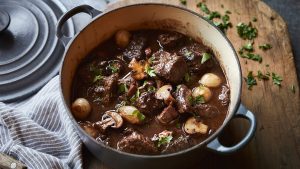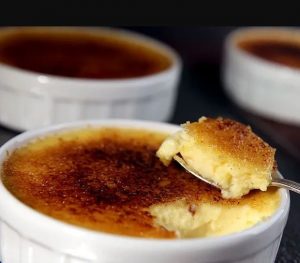Starters/Appetizers/Soups
-
Roman Lentil Soup

Roman Lentil Soup is one of the Europe’s oldest recipes. it is a simple yet hearty dish that dates back to ancient Rome. The Romans commonly ate a soup made with lentils, vegetables, and spices such as cumin and coriander. It was a staple in their diet and served to both soldiers and common people. The soup provided nutrition, was simple to prepare. It could be made with a range of ingredients, depending on what was accessible.
-
Garum
Garum was a popular condiment in ancient Rome, made from fermented fish. People used Garum in a variety of dishes, from soups and stews to meat and vegetables, and highly prized the sauce for its unique umami flavor. People exported Garum throughout the Roman Empire, and despite its pungent smell, they considered it a delicacy and even used it in medicinal remedies.
-
Tyrokafteri

Tyrokafteri is a spicy cheese dip that originates from Greece. Made with feta cheese, hot peppers, and olive oil, it has a creamy texture and a bold, spicy flavor. In Greek cuisine, people often serve Tyrokafteri as an appetizer or meze dish and typically enjoy it with bread or pita chips. Various regions throughout the Mediterranean add their own unique twists to the recipe.
-
French Onion Soup

People have enjoyed French Onion Soup as a classic dish in France for centuries. People make this soup with caramelized onions, beef broth, and a hearty bread crouton topped with melted cheese, which gives it a rich, savory flavor and comforting warmth that makes it perfect for cold winter nights. The dish originated in the French countryside, and farmers and laborers often served it as a hearty and filling meal. Nowadays, French Onion Soup is a beloved dish that restaurants all around the world serve.
Main Meals
-
Haggis

Haggis is a traditional Scottish dish that is made from sheep’s offal (heart, liver, and lungs) mixed with oats, onions, and spices, and then encased in a sheep’s stomach and boiled. Haggis has a hearty and savory flavor that people often describe as earthy and nutty. People typically serve it with “neeps and tatties,” which are mashed turnips and potatoes. Haggis is a staple dish at Scottish celebrations such as Burns Night and St. Andrew’s Day. While it may not be for everyone, haggis is a beloved dish in Scotland and a unique culinary experience for those willing to try it.
-
Beef Bourguignon

Beef Bourguignon is a classic French stew that is made with beef, red wine, bacon, onions, and mushrooms. In beef bourguignon, cooks typically marinate the beef in wine before searing and slow-cooking it with other ingredients to produce a rich and flavorful dish. The dish is typically accompanied by crusty bread, mashed potatoes, or pasta and is a popular winter comfort food in France and around the world. Beef Bourguignon originated in the Burgundy region of France, where it is still a beloved and traditional dish.
-
Wiener Schnitzel

Wiener Schnitzel is a traditional Austrian dish made from breaded and fried veal cutlets. In Wiener Schnitzel, one typically pounds veal thinly, coats it in flour, eggs, and breadcrumbs, and fries it until it turns golden brown. It is served with a wedge of lemon, parsley, and a side of potatoes or salad. Austria loves the dish, and it is often considered the national dish. It has also become popular worldwide and is now available on many international menus.
-
Moussaka

People make Moussaka, a classic Greek dish, by layering sliced and salted eggplant with ground meat (usually beef or lamb) and a creamy béchamel sauce. They typically fry or bake the eggplant before layering it with the meat sauce and topping it with the béchamel. The dish is then baked until golden brown and bubbly. People often serve Moussaka as a main dish, and it is a popular comfort food in Greece and other Mediterranean countries. While there are many variations of moussaka, the classic version is a staple in Greek cuisine.
-
Coq au Vin

Coq au Vin is a classic French dish that originated in the Burgundy region. People make Coq au Vin by cooking chicken, bacon, mushrooms, onions, and garlic in red wine until the chicken is tender and the sauce is rich and flavorful. They typically marinate the chicken in red wine before cooking, which gives it a deep, complex flavor. Coq au Vin is often served with crusty bread, mashed potatoes, or noodles. It is a popular comfort food in France and around the world. It is a perfect dish for a cozy winter evening or a special occasion.
-
Osso Buco

This traditional Milanese is one of the highlights of Europe’s oldest recipes. Dish dates back to the 19th century and consists of veal shanks cooked slowly with vegetables, white wine, and broth. It is typically served with a gremolata, a mix of chopped parsley, lemon zest, and garlic, to add brightness to the rich and flavorful dish.
-
Irish Stew

A hearty and comforting dish that has been enjoyed in Ireland for centuries. The original recipe consists of lamb, potatoes, onions, and herbs, but variations with beef or other meats are also common. The stew is typically simmered for hours, allowing the flavors to meld together and create a warming and satisfying meal.
-
Pörkölt

A traditional Hungarian dish that is similar to goulash, but with a thicker sauce and more paprika. In Pörkölt, people typically make the dish with beef, onions, tomatoes, and peppers, and then serve it with a side of egg noodles or bread dumplings. Hungarian people have been enjoying this comforting and flavorful meal for centuries.
-
Paella

People have been enjoying Paella, a traditional Spanish dish that originated in the Valencia region, for centuries. The dish usually consists of saffron-seasoned rice, chicken, rabbit, and a variety of seafood like shrimp, mussels, and squid. Peppers, onions, and tomatoes can also be added to the dish. To cook Paella, people use a large, shallow pan called a paellera and often serve it as a communal dish for a group to share.
Desserts
-
Baklava

Let’s continue Europe’s oldest recipes with desserts. Baklava is a sweet pastry that originated in the Middle East and is now a popular dessert in many countries. Baklava consists of layers of phyllo dough, chopped nuts (usually pistachios or walnuts), and a sweet syrup made with honey, sugar, and water. To achieve a flaky and crispy texture, people brush the phyllo dough with butter or oil between each layer. Baklava is often garnished with more nuts and served with a scoop of ice cream or a cup of Turkish coffee. It is a decadent and delicious dessert. It is perfect for special occasions or a sweet treat any time of the year.
-
Tiramisu

Tiramisu is a classic Italian dessert that is made with layers of coffee-soaked ladyfingers, creamy mascarpone cheese, and a dusting of cocoa powder. People typically use a mixture of espresso and liquor (such as marsala or amaretto) to dip ladyfingers, giving them a rich and intense flavor for tiramisu. They create the filling by whipping mascarpone cheese with sugar and egg yolks, resulting in a light and fluffy texture that they layer between the soaked ladyfingers. People often chill tiramisu before serving, and it is a popular dessert in Italian restaurants worldwide.
-
Crème Brûlée

Crème Brûlée is a classic French dessert that consists of a rich and creamy custard topped with a caramelized layer of sugar. Typically, people make custard with egg yolks, cream, vanilla, and sugar, and bake it in a water bath until it sets. Once baked, they chill the custard and sprinkle sugar on top. They then caramelize with a culinary torch or under a broiler until it forms a crispy, golden brown crust. Fine dining restaurants often serve Crème Brûlée, a decadent and sophisticated dessert loved by many dessert enthusiasts.
-
Sachertorte

Sachertorte is a famous chocolate cake that originated in Vienna, Austria. The cake consists of a dense chocolate cake base, filled with apricot jam, and covered in a smooth chocolate glaze. Franz Sacher created Sachertorte in 1832 for Prince Wenzel von Metternich, and it has since become a beloved dessert in Austria. People typically serve Sachertorte with whipped cream and a hot cup of coffee, and both locals and tourists enjoy it. The cake’s rich and indulgent flavor makes it a perfect treat for chocolate lovers.
-
Trifle

Trifle is a classic English dessert that consists of layers of fruit, custard, sponge cake, and whipped cream. People typically assemble the dessert in a glass bowl, with each layer adding distinct flavors and textures. The sponge cake is usually soaked in sherry or fruit juice to enhance its flavor and moisture content. The fruit used in the dessert may vary based on personal preference or the season. Trifle is a popular dessert during holidays and special occasions in the UK. Its sweet and creamy texture makes it a favorite among dessert lovers.
Exploring Europe’s oldest recipes is a fascinating journey through time and culture, and one that food lovers and history enthusiasts alike can enjoy.
Read more blogs here:
- Essential Peruvian Food: 10 Must-Eat Dishes to Seek Out
- Filipino Food: 16 Best Dishes to Try in the Philippines
- Spain-taneous Flavor: Indulge in These Must-Try Spanish Dishes


